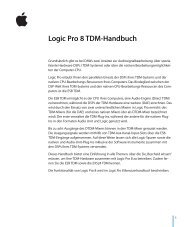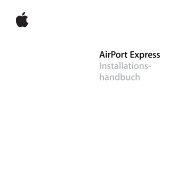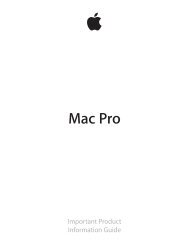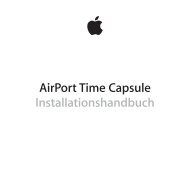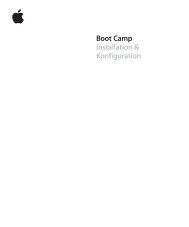iPhone User Guide - Support - Apple
iPhone User Guide - Support - Apple
iPhone User Guide - Support - Apple
You also want an ePaper? Increase the reach of your titles
YUMPU automatically turns print PDFs into web optimized ePapers that Google loves.
Important: Clock alarms, audio apps such as Music, and many games play sounds through the<br />
built-in speaker, even when <strong>iPhone</strong> is in silent mode. In some areas, the sound effects for Camera<br />
and Voice Memos are played, even if the Ring/Silent switch is set to silent.<br />
For information about changing sound and vibration settings, see Sounds and silence on<br />
page 31.<br />
Use Do Not Disturb. You can also silence calls, alerts, and notifications using Do Not Disturb.<br />
Swipe up from the bottom edge of the screen to open Control Center, then tap . See Do Not<br />
Disturb on page 31.<br />
Status icons<br />
The icons in the status bar at the top of the screen give information about <strong>iPhone</strong>:<br />
Status icon<br />
Cell signal<br />
Airplane mode<br />
LTE<br />
UMTS<br />
UMTS/EV-DO<br />
EDGE<br />
GPRS/1xRTT<br />
Wi-Fi<br />
What it means<br />
You’re in range of the cellular network and can make and receive<br />
calls. If there’s no signal, “No service” appears.<br />
Airplane mode is on—you can’t make phone calls, and other<br />
wireless functions may be disabled. See Travel with <strong>iPhone</strong> on<br />
page 39.<br />
Your carrier’s LTE network is available, and <strong>iPhone</strong> can connect to<br />
the Internet over that network. (<strong>iPhone</strong> 5 or later. Not available in all<br />
areas.) See Cellular settings on page 153.<br />
Your carrier’s 4G UMTS (GSM) or LTE network (depending on carrier)<br />
is available, and <strong>iPhone</strong> can connect to the Internet over that<br />
network. (<strong>iPhone</strong> 4s or later. Not available in all areas.) See Cellular<br />
settings on page 153.<br />
Your carrier’s 3G UMTS (GSM) or EV-DO (CDMA) network is available,<br />
and <strong>iPhone</strong> can connect to the Internet over that network. See<br />
Cellular settings on page 153.<br />
Your carrier’s EDGE (GSM) network is available, and <strong>iPhone</strong> can<br />
connect to the Internet over that network. See Cellular settings on<br />
page 153.<br />
Your carrier’s GPRS (GSM) or 1xRTT (CDMA) network is available, and<br />
<strong>iPhone</strong> can connect to the Internet over that network. See Cellular<br />
settings on page 153.<br />
<strong>iPhone</strong> is connected to the Internet over a Wi-Fi network. See<br />
Connect to Wi-Fi on page 15.<br />
Do Not Disturb “Do Not Disturb” is turned on. See Do Not Disturb on page 31.<br />
Personal Hotspot<br />
Syncing<br />
Network activity<br />
Call Forwarding<br />
VPN<br />
TTY<br />
<strong>iPhone</strong> is providing a Personal Hotspot for another device. See<br />
Personal Hotspot on page 32.<br />
<strong>iPhone</strong> is syncing with iTunes.<br />
Shows that there’s network activity. Some third-party apps may also<br />
use it to show an active process.<br />
Call Forwarding is set up. See Call forwarding, call waiting, and caller<br />
ID on page 47.<br />
You’re connected to a network using VPN. See Network access on<br />
page 143.<br />
<strong>iPhone</strong> is set to work with a TTY machine. See TTY support on<br />
page 142.<br />
Chapter 1 <strong>iPhone</strong> at a Glance 12




